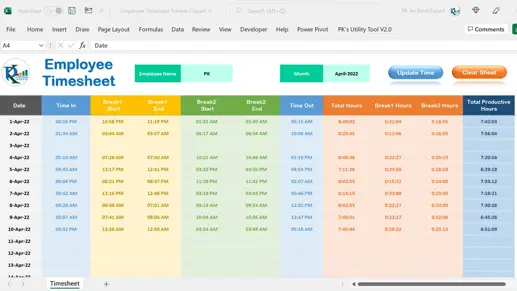How to Make an Excel Timesheet In Excel: A Step-by-Step Guide
Time tracking is crucial for project management, keeping track of working hours, or even just for knowing how much time you spend on each task each day. You can make timesheets like an expert with Excel's assistance. Aniday will go over each step in detail and examine Excel's features for effective time tracking in this blog.

Step 1: Create Your Table
The first step in making an Excel timesheet is to create a table. To do this:
-
Open Excel and create a new spreadsheet.
-
In the first row, set up the following column headers: Date, Start Time, End Time, Total Hours, Task/Project, and Notes.
-
Your timesheet is now ready to receive data.
Step 2: Add Dates and Times
In the Date column, enter the dates for the period you want to track. For the Start Time and End Time columns, input the time you start and finish each task. Excel accepts a variety of time formats. For example, you can use "7:00 AM" or "18:20 PM."
Step 3: Add Hour Types
If you're tracking different types of work, you may want to add an "Hour Type" column. This could include categories like regular hours, overtime, or break times. This will help you differentiate and calculate hours worked for specific purposes.
Step 4: Add Identifying Information
In the Task/Project column, specify the project, client, or task associated with the hours worked. This makes it easier to keep your time entries organized.
If needed, use the Notes column to add any additional information or comments related to your tasks.
Step 5: Adding Formulas
Excel's true power lies in its ability to perform automatic calculations. To calculate the Total Hours worked for each task or day, you can use Excel formulas. Here's how:
In the first cell of the Total Hours column (D2), use the formula =C2-B2 to subtract the Start Time (B2) from the End Time (C2). This will calculate the hours worked for that specific task.
Copy this formula down to calculate total hours for all your entries.
Step 6: Make It Pretty
A well-organized and visually appealing timesheet is easier to work with. You can format your timesheet by adjusting cell formatting, adding borders, and using colors to highlight important information. For example, you can format date cells to show them as dates and use conditional formatting to highlight overtime hours.
Step 7: Adding Hours Worked
The total number of hours worked during a given time period (such a week or month) can be determined using the SUM function. Type the formula =SUM(D2:Dn), where "n" is the last row of data, in a cell that is inserted beneath the Total Hours column. Thereafter, the amount of hours actually worked will be totaled.
Step 8: Printing
You might want to print your timesheet for submission or documentation after entering and organizing your time tracking data. Click the "File" tab, select "Print," and then customize the print settings to your needs. Having a paper copy of your timesheet available at all times is now a possibility thanks to this.
How to Customize an Excel Timesheet Template

While using an Excel timesheet template can save you time and work, tailoring it to your unique requirements can increase the effectiveness and aesthetic appeal of your time tracking. This section will examine the various ways in which an Excel timesheet template can be altered.
1. Format Cells in Excel
Formatting cells in your Excel timesheet template is essential for clarity and organization. Here's how to format cells:
-
Select the cells that need formatting.
-
Right-click and select "Format Cells."
-
You can change a lot of formatting options, including borders, alignment, and numerical format (for example, time format).
2. How to Change Fonts
Changing fonts can improve the readability and visual appeal of your timesheet. To change fonts:
-
Select the cell or range of cells where the font has to be altered.
-
Click the "Font" dropdown in the Home menu, you can select the font type, size, and color that you prefer.
3. How to Add or Change Background Colors of Cells
Adding or changing background colors can help differentiate and highlight specific information. To change cell background colors:
-
The cell or range of cells you want to alter should be selected.
-
To select your preferred backdrop color, click the "Fill Color" dropdown in the Home menu.
4. How to Add Logos and Images
If you want to personalize your timesheet with a logo or an image, you can do so as follows:
-
Go to the "Insert" tab.
-
Click on "Picture" or "Online Pictures" to insert an image.
-
Position and resize the image as needed.
5. How to Add Columns to Track Breaks
Adding columns for tracking breaks can be especially useful if you want to monitor and account for time spent on breaks during work hours. To add columns:
-
To add a new column, right-click the column's header.
-
A new column will be added when you choose "Insert". Put appropriate labels on it, such as "Break Start" and "Break End."
6. How to Protect a Range of Cells in Excel Timesheet in Microsoft Enterprise 365
If you're using Microsoft 365 Enterprise, you can make use of Excel's protection features to protect specific cells in your timesheet from unintended changes:
-
Pick the cells that you want to keep safe.
-
Select the "Review" tab.
-
Click on "Protect Sheet."
-
You can set a password for added security.
-
Choose which elements you want to allow users to edit or not edit.
7. How to Protect a Range of Cells in Microsoft 365 Excel
You can take similar actions to secure a group of cells if you're using Microsoft 365 Excel (formerly known as Office 365):
-
Pick the cells that you want to keep safe.
-
Select the "Review" tab.
-
To configure your protection choices, click "Protect Sheet".
-
You can specify which actions are allowed, such as selecting cells, formatting cells, or editing objects.
-
Set a password if desired.
Excel Timesheet Templates

Creating a timesheet from scratch can be time-consuming. Fortunately, there are numerous Excel timesheet templates available online. These templates often come with pre-designed formatting and formulas, saving you time and ensuring accuracy in your time tracking.
Can You Use Excel as a Time Clock?
While Excel can help you track time, it's not a replacement for a dedicated time clock system. Excel requires manual data entry and is susceptible to human error. A dedicated time clock system, on the other hand, offers automated time tracking, better accuracy, and more features.
Time Tracking in Excel: Pros and Cons
For businesses and individuals wishing to track their productivity, manage projects, and keep track of billable hours, time tracking in Excel is a standard practice. Excel offers advantages and disadvantages when it comes to time monitoring, just like any other product.
1. Pros
-
Flexibility: You can create a timesheet tailored to your specific needs.
-
Customization: Excel allows you to adapt the timesheet as your tracking requirements change.
-
Inexpensive: Excel is readily available, and you may not need to invest in additional software.
2. Cons
-
Manual Entry: Data entry is time-consuming and prone to errors.
-
Limited Automation: Excel doesn't offer automated tracking like dedicated time clock software.
-
Version Control: Sharing and collaborating on Excel timesheets can lead to version control issues.
Through this article, Aniday hopes that you have learned "How to make a timesheet" in our comprehensive guide, which includes setting up a well-structured table, inputting data accurately, using calculations, and formatting it for optimal clarity. Excel is indeed a versatile tool for time tracking, making it a valuable asset for personal or small-scale time management needs.
Aniday's HR Services
Headhunting Service
Find and recruit quality candidates in just 1 week! Supported by 40,000 experienced headhunters in IT, Finance, Marketing… capable of recruiting in any region.
Headhunting Service ➔Employer of Record (EOR) Service
On behalf of your business, we recruit employees and handle payroll without the need to establish a company in markets such as Vietnam, Singapore, Malaysia, India, Indonesia…
Employer of Record (EOR) Service ➔